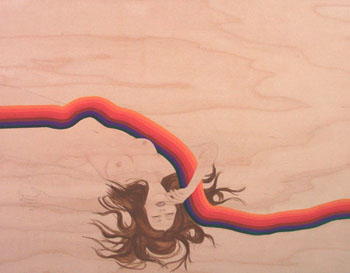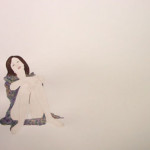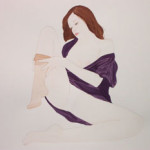The pin-up girls in Suzannah Sinclair’s drawings are not particularly interested in the viewer. With a gaze that is either inwardly focused or off into space, they seem bored more than they are concerned with being sexy. However, not portraying sexuality is impossible for these beauties who pose provocatively with their panties and lacey things. Sinclair has caught these models in the moment between snap shots- in the pose, but not quite posing. However, appealing to the proverbial “male gaze” these models do not, the drawings are not about male fantasy but the models themselves. Why are they so sad? So bored? Perhaps melancholic describes them best, yet what they are mourning is not exactly clear.
Sinclair’s skills are best seen in the details and articles of clothing these women adorn: The flannel shirt a strait-haired woman covers herself with, the lacey camisole that sits atop another so delicately, or the pantyhose that is either being taken on or off. These details and flourishes (she clearly loves painting the transparent clothing) do not necessarily enhance the sexuality of the women. In an odd way, the women are in service of the clothing, making the articles just as significant. This is reinforced in all the work made on maple panels, as the women’s bodies are that of the background, and often just fade to grain.
A preoccupation with figure/ground relationships seems to be the impetus for a wall drawing of a rag rug adjacent to the main installation. This picture is the most colorful piece in the show and has a sex appeal of its own. Like the clothing, the rug can be seen as a prop that has the same amount of importance as the women. The transparent watercolor over the surface of the wall and controlled brushwork make the pattern dance with color and light. The rug, along with a few drawings that incorporate the same palette, stylistically tie the work to a specific period: the free loving 60s.
The social turmoil and sexual freedom of the late 60s and early 70s can be seen as a backdrop for the psychology of these women. Not that these women are hippies, but perhaps they are portrayed so sad because they wish they were, or more accurately, Sinclair wishes them free of a one-dimensional portrayal. This is perhaps the one thing that separates Sinclair from a million other artists who have taken the pin-up as their subject. Approached with affection, care and nostalgia, Sinclair does not seem to push a particular critique of feminist discourse as she is exploring the psychological weight of the women and her lure to them.
If Sinclair is trying to instill subjectivity in these women, it is not without struggle. How does one conjure empathy for women that were never meant to be “real”? The critique of pin-ups has been played a hundred times, yet Sinclair’s work does not seem to fall into expected and well rehearsed complaints about the objectification of women. In these drawings there seems to be a sinister sincerity in the women’s portrayal. Not because they are being exploited, but because they seem to be so unfulfilled. Nostalgia for a time when things were better, more open, more free permeates the work, however it is a longing that Sinclair did not experience. Born well after the heyday of this idealism, Sinclair has experienced this period only as a second hand concept, not a reality.
This places her in well-tread discourse. Carol Bove is just one of many other artists who are working through this time period, looking for a kind of subjective make-up that can embody the time period. Bove’s simple yet precise arrangements and drawings have a much more sophisticated distance to the period, while Sinclair does not seem to offer anything new or different to a larger discourse of 1960s concepts. The pin-up girl has been claimed and persecuted many times over and Sinclair does not offer awareness of this history. What she does offer is innocent infatuation with these women that is both tired and surprisingly affectionate.
Links:
Samson Projects
"Suzannah Sinclair: Lost Weekend" is on view from January 6th- 28th at Samson Projects.
All images are courtesy of the Suzannah Sinclair and Samson Projects.







